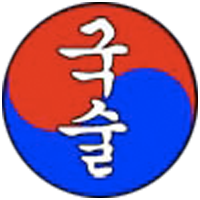Our Martial Arts History
A Modest Background of the Style that We Teach

Kuk Sool
(Traditional Korean Martial Arts)
Kuk Sool has countless techniques which are said to derive from the three branches of historical Korean martial arts: Sah Doh Mu Sool, Koong Joong Mu Sool, and Bull Gyo Mu Sool. But the joint-locks and other grappling aspects are identical to those found in Hapkido, which is historically proven to be drawn from a Japanese art known as Daito Ryu Aiki-Jujitsu, while the forms of patterned movements and palm-striking can be linked to a Chinese art known as Tang Lang Chuan (i.e. praying mantis kung-fu). However, the curriculum does have a uniquely designed structure that successfully combines all of these elements, along with other skills and training methods which are of Korean origin, and thus can take a practitioner in a logical progression from the beginning all the way up to Master level.
All of the aforementioned elements, whether actually stemming from these historical Korean martial arts or gleaned elsewhere, were brought together and organized to form a single system in the late 1950’s to early 1960’s, under a group known as the Kuk Sool Hwe (short for: Han Kuk Mu Sool Hyup Hwe, or “Korean Martial Arts Association”). Several renowned martial art masters were responsible for this accomplishment, including Woo-tak Kim, In-hyuk Suh, Joo-bang Lee, and Han-chul Lee, to name a few. Unfortunately this unfettered cooperation was short-lived and as a result, this epic organization subsequently disbanded, with the 4 masters listed eventually going their separate ways. Nonetheless, they each continued to pursue such efforts individually and are responsible for forming the following martaial art systems, all built on the contents of this unique conglomeration of various martial skills, now identified as Kuk Sool: Kuk Sool Kwan (f. Woo-tak Kim), Kuk Sool Won (f. In-hyuk Suh), Hwa Rang Do (f. Joo-bang Lee), and Bul Mu Do (f. Han-chul Lee).
In the last 50 years, perhaps the most influential figure who has been actively promoting the martial art of Kuk Sool (under that name), is In-hyuk Suh along with his organization, the World Kuk Sool Association, Inc., which proclaims to have an extensive following throughout the world. But there are many other institutions not affiliated with him or his organization which have also helped acknowledge the remarkableness of Kuk Sool and thus it is often recognized in the martial arts community as one of the most effective and comprehensive traditional Korean martial arts in existence today. For example, Kuk Sool is highly revered and even preferred as a variant of Hapkido by the Han·min·jok Hapkido Association and the World Kido Federation, both headed by In-sun Seo, and these two organizations can assert to having numerous members all across the globe.
Hwa Rang Do has always been a significant group that showcases traditional Korean martial arts and just like Kuk Sool Won, remained highly visible and well respected ever since its emergence during the post Korean War era. The major difference is that Hwa Rang Do went to great lengths to distance itself from its roots with the South Korean “Kuk Sool movement” of the 1960’s, especially after the relocation of its headquarters to the USA in 1972. Kuk Sool Kwan, due to a fateful misunderstanding concerning leadership and exactly who was in charge, suffered through a period of relative obscurity that lasted several decades. But it has shown an international resurgence recently, providing it with the recognition it rightly deserves. Likewise, Bul Mu Do which never attained the high acclaim as similar martial art systems with roots in the Kuk Sool Hwe, did manage to foster serious research into traditional Korean fighting methods by engaging the assistance of Dr. Kyung-bo Seo, aka Buddhist monastic “Il Bung.” Together, Seo & Lee helped formulate the Korean Buddhist Martial Arts Research Institute, which later refocused attention less to research and more to disseminating this unique perspective of physical combat. Han-chul Lee eventually left, relocating to South America, and Dr. Seo turned over the reins of the Korean Buddhist Martial Arts Assoc. to the Most Venerable Son Hae, who ran its operations for over 30 years and once again named a new successor in 2015 [the Most Venerable Sunyananda Dharma, a highly qualified and proven martial artist as well as a notable Zen adept]. Now this organization is looking to a heightened stature compared to previously when it was dwarfed by larger, more affluent, martial art organizations.
Alas, worldwide exposure led to its exponential growth and prestige, but since the WKSA is little more than a “family business” (and questionably due to how it’s run), there’s an inordinate amount of martial artists who have been introduced to the art of Kuk Sool and feel it’s the ultimate in terms of incorporated skills, training methods, ideology, etc., yet can’t tolerate the dictates of the WKSA leadership. Over the many years of WKSA’s existence, this telltale trait has been repeated often and thus it has led to the formation of many “offshoots” whether utilizing the name Kuk Sool or not, and all of these martial art organizations add to the recognition and high regard given to this unique system of martial arts.
Please visit the Kuk-Sool Global Alliance for more information about Kuk Sool.
